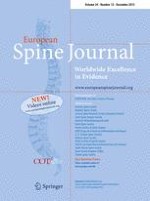01-12-2015 | Original Article
Predictors of surgical outcome in cervical spondylotic myelopathy: focusing on the quantitative signal intensity
Published in: European Spine Journal | Issue 12/2015
Login to get accessAbstract
Purpose
The association between intramedullary increased signal intensity (ISI) on T2-weighted magnetic resonance imaging and surgical outcome in cervical spondylotic myelopathy (CSM) remains controversial. The purpose of this study is to assess the impact of quantitative signal change ratio (SCR) on the surgical outcome for CSM.
Methods
The prospective study included 108 consecutive patients who underwent surgical treatment for CSM. The Japanese Orthopaedic Association (JOA) score and recovery rate were used to evaluate clinical outcomes. JOA recovery rate less than 50 % was defined as a poor clinical result. The SCR was defined as the signal intensity at the level of ISI or severely compressed cord (in cases with no ISI) divided by the signal intensity at the C7–T1 disc level. Age, sex, body mass index, duration of symptoms, surgical technique, preoperative JOA score, levels of compression, preoperative SCR, preoperative C2–7 angle, preoperative C2–7 range of motion were assessed.
Results
Forty patients (37.0 %) had a recovery rate of less than 50 %. Multivariate logistic regression analysis revealed that a higher preoperative SCR and a longer duration of symptoms were significant risk factors for a poor clinical outcome. Receiver operating characteristic (ROC) curve analysis showed that the optimal preoperative SCR cutoff value as a predictor of poor clinical result was 1.46. The area under the ROC curve of preoperative SCR for predicting a poor surgical outcome was 0.844.
Conclusions
Preoperative SCR significantly reflected the surgical outcome in patients with CSM. Patients with SCR greater than or equal to 1.46 can experience poor recovery after surgery.





